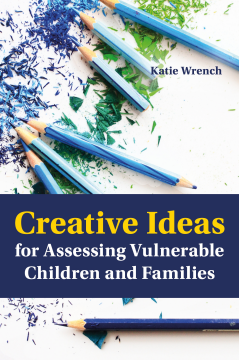
Additional Information
Book Details
Abstract
For the busy frontline practitioner with little time to plan ahead, this hands-on guide presents imaginative and unique methods to engage families and caregivers throughout the process of assessing vulnerable children.
Setting the context for each area of assessment, including strengths and resilience, risk and needs and the child's lived experience, the book then describes a series of activities or creative techniques to engage young people and their caregivers within this area. It outlines the materials required, aims of the exercise and method. It includes 'handy hints' based upon practical experience, making it a quick go-to guide for every day practice.
It encourages practitioners to focus on building safety into relationships and to adapt their approach to take into account the impact of trauma and abuse on an individual's capacity to engage and to communicate verbally.
Practitioners, assessing vulnerable children and young people, must engage with them in order to understand their experiences, wishes and feelings. The wide range of imaginative activities included in this book provide a rich resource for busy workers. The activities enable practitioners to engage with children and young people in innovative and meaningful ways.
Jan Horwath, Emeritus Professor of Child Welfare in the Department of Sociological Studies at the University of Sheffield
The author has produced a book that is written with insight and deep understanding and appreciation of direct work with children, young people and their families. This text will appeal to a broad readership that will include social work student, experienced social workers and practitioners working with children. Katie continues to bring depth to this area with a range of tools and frameworks that can be used to strengthen the voices of children in their plans and assessments. Thank you Katie, a must read and it is on my book shelf.
Lee Pardy-Mclaughlin, Coventry City Council
As someone who has been through the care system I appreciate the impact decisions made during assessments can have on children and young people.
This book offers practitioners creative quality tools which will benefit practitioners and families alike. I encourage all practitioners involved with families to have a read and to use the learning to make the difference to children and young people. We deserve this!
Shianne Kinchen, a care experienced young person working with Coventry City Council
Katie Wrench has been a therapeutic social worker for 15+ years, as well as an art psychotherapist. She is currently the manager of the Therapeutic Social Work Team at Leeds Children's Social Work Service.
Table of Contents
| Section Title | Page | Action | Price |
|---|---|---|---|
| Creative Ideas for Assessing Vulnerable Children and Families | 1 | ||
| Introduction | 9 | ||
| Ch 1. Building Safety into the Assessment Process | 28 | ||
| Ch 2. Communication and Creativity | 40 | ||
| Ch 3. Exploring Protective Factors in Children and Families | 67 | ||
| Combined Skills and Strengths | 71 | ||
| Identifying Personal Networks | 74 | ||
| Strengths-based All About Me | 77 | ||
| The Memory Bank | 79 | ||
| The Tree of Life | 81 | ||
| Count Your Blessings | 84 | ||
| Ch 4. Exploring and Understanding the Nature of Relationships | 85 | ||
| Faces Technique | 97 | ||
| Queen or King of the Island | 98 | ||
| Relationships: Okay, Difficult, Wrong | 100 | ||
| Our Street or Our Community | 103 | ||
| Buttons and Beads | 104 | ||
| The Empty Chair | 105 | ||
| Ch 5. Hearing the Family Stories | 108 | ||
| Genogram or Family Tree | 111 | ||
| Draw Your Family | 115 | ||
| Ecomap | 117 | ||
| Life Graph or Life Map | 120 | ||
| Sculpting | 123 | ||
| Story in a Box | 125 | ||
| Ch 6. Exploring Everyday Lived Experience | 128 | ||
| A Day in the Life | 138 | ||
| Six-Part Story Making | 142 | ||
| Welcome Mat | 145 | ||
| My House or My Castle | 147 | ||
| My Three Houses | 148 | ||
| Doll’s House Play | 150 | ||
| Ch 7. Talking About a Specific Event | 152 | ||
| What’s the Weather Like? or Weather Report | 155 | ||
| Secrets and Secret Enablers | 157 | ||
| Hot Cross Bun | 161 | ||
| Telling My Story | 164 | ||
| Bag of Feelings | 169 | ||
| Behaviour Chain Analysis | 172 | ||
| Ch 8. What’s the Problem? | 175 | ||
| Reframing | 179 | ||
| Externalising the Problem | 180 | ||
| Worry Tree | 184 | ||
| Building Strong Walls | 184 | ||
| The Parenting Game | 187 | ||
| The Needs Jigsaw | 193 | ||
| Ch 9. Assessing Change Factors | 195 | ||
| Scaling or Likert Scales | 203 | ||
| The Future Self Drawing | 207 | ||
| Make a Wish | 209 | ||
| Wall or Tree of Hope | 210 | ||
| What’s Your Anchor? | 212 | ||
| Stepping Stones | 213 | ||
| References | 216 | ||
| Subject Index | 223 | ||
| Author Index | 230 | ||
| Blank Page |
